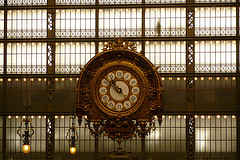Visit to Paris so far this weekend has included: Musée du Louvre, Tour d’Eiffel, Musée d’Orsay, Espace Dali, and Musée Picasso.
At the Louvre, everyone packed certain exhibition halls to see the Mona Lisa, the Winged Victory of Samothrace, the Venus de Milo, and a few other prominent pieces. At Orsay, everyone crowded the Vincent Van Gogh rooms. Why?
Works such as Liberty Leading the People by Delacroix because of its cultural commentary about the French Revolution or Hommage to Cézanne by Denis because of its ironical retelling of impressionism. Or countless other individual pieces.
Art is for the creator and the viewer. It’s important to understand what it means to you. What society says means nothing because individuals must establish their own truth. Art could simply be a venue for quiet reflection. Or the artist could speak personally to the audience. But blindly accepting conventions is nothing. This is a bit of a House-like argument (the character is criticized in episodes as a hypocrite because he does seek to break rules but only wants to substitute his own for society’s). It would be cheaper to walk in a park and talk mindless photos.
Many works are best appreciated from a distance, usually greater than six inches. I don’t understand the temptation to take photos of every work in a museum. Is it because people won’t believe that they actual visited the collection? Most museums have databases or catalogues, compiled by photographers with better equipment and greater skill than amateurs. If one spends some much time viewing things through a lens, how does one see the big picture and develop their own ideas?
I don’t know how to take excellent photographs. I try to find perspectives that pique my interest or seem out of the ordinary. “Natural Light” is a photo that captures visitors to the Musée d’Orsay who while visiting an exhibit on shadow theatre might not realize they are part of a show for those in the main hall.
And it didn’t make use of flash photography. Most museums have signs mentioning that flashes or cameras are not permitted. The main reason is that flashes damage certain works within six to twelve feet, especially tapestries, objets d’art, and some prints. It’s akin to touching a sculpture to a degree. At the Picasso Museum, a gentleman was endeavouring to take a flash photo of a rare Picasso tapestry when a woman walked in front of him to use the stairs. The would-be photographer criticized the stair-climber and demanded an apology. At other museums, visitors were taking pleasure in destroying some of Salvador Dali’s most original artwork (in terms of style and technique, an aspect for which he doesn’t get as much credit for his creativity).
Where did such ignorant self-importance come from? People have to insert themselves in photos everywhere, often blocking access. Again, is it because people won’t believe they visited the location? I try to keep photo-taking sparse and improve the overall quality of the collection. It impedes collective functionality for individual self-indulgence (usually with poor form). Why does the world tolerate so much idiocy?
